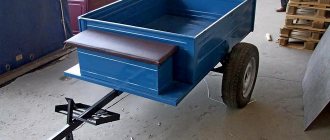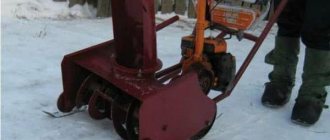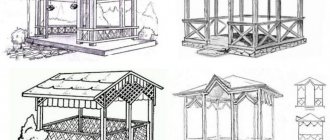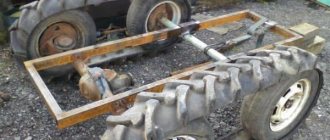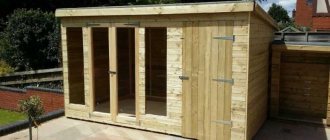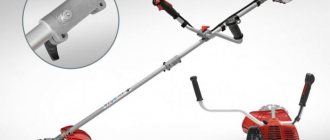Work on a plot of land, be it loosening, digging or hilling, takes a lot of time and effort. Therefore, many gardeners, in order to facilitate the work of cultivating the land, purchase auxiliary special equipment - walk-behind tractors. Using this universal unit, you can perform a whole range of diverse work, starting with cleaning the site and cultivating the land, and ending with transporting the harvested crop and any cargo. But it is impossible to weed, hill up or simply remove snow and construction waste without attachments - an adapter. A specially equipped cart with a seat, which turns a walk-behind tractor into a mini-tractor, is quite expensive in stores. Making an adapter for a walk-behind tractor with your own hands is a completely feasible task, which can be completed by an owner with a technical creative streak.
What it is?
An adapter for a walk-behind tractor is a trolley, the main elements of which are a seat, a brake, a brake handle, footrests, a coupling mechanism and a frame with structural parts attached to it.
The brake of the device is located near the foot rest. Typically, such a device is equipped with two wheels, and the seat often has a lifting lever. The design of the adapter can be either universal or special: some of these varieties provide for additional fastening of various canopies.
Equipping the walk-behind tractor with an adapter practically turns the working unit into a mini-tractor with a seat that increases operator comfort.
Purpose of the device
A walk-behind tractor is a type of agricultural machinery and is used for plowing, harrowing and cultivating the soil.
The main advantages of the unit are its mobility and versatility. Different attachment options allow you to use the walk-behind tractor for a wide range of country work, regardless of the season - for example, in winter you will need it for clearing snow on your property.
The most significant drawback of walk-behind tractors in the basic configuration is that they need to be led across the garden bed like a horse. That is why many craftsmen improve the two-wheeled assistant by making an adapter for it. This upgrade allows the walk-behind tractor to transform into a mini-version of the tractor.
Application area
If we consider in general the purpose of adapters for walk-behind tractors, then their purpose is to relieve the user and make his hard work easier. Depending on what type of auxiliary equipment is attached to the walk-behind tractor, its scope of use can expand significantly.
For example, in addition to plowing, weeding, hilling and harvesting root crops, it will be possible to remove hay, clear some types of surfaces from snow, and level the soil surface. In addition, it will be possible to transport oversized cargo.
Structure care
In order for the minitractor to serve for many years, it is recommended to follow the operating rules, which are as follows:
- monitor the quality of the fuel.
- control the direction of the knives when installing canopies for cultivation.
- close the air supply when starting a cooled device into operation.
- Limit speed when warming up the engine.
An adapter for a walk-behind tractor with your own hands is not only significant savings, but also provides comfort based on personal preferences
To facilitate labor-intensive work when cultivating agricultural land, mowing the lawn or removing snow, you can control the walk-behind tractor using an adapter.
What types of adapters for walk-behind tractors are there?
Externally, the adapter design is a small frame with two wheels, a platform for feet, a drawbar and a seat for the operator. By equipping a walk-behind tractor with such a “new thing”, you will actually turn it into a mini-tractor - working will become much more convenient, faster and easier, and the ability to adjust the seat will make the work process more comfortable.
There are several types of adapters for walk-behind tractors. In order to buy or make the most suitable option for you, you should familiarize yourself with all types of this equipment.
Based on the type of clutch, adapters are divided into adapters with steering and movable joints. Depending on the location - on the front adapters and rear ones.
Adapters can also be classified into a separate classification based on the purpose of use: with an extended drawbar for powerful large walk-behind tractors, with a shortened drawbar for small, lightweight units.
Adapter with steering
This type is on a rigid joint with a walk-behind tractor. The steering is represented by a separate unit, and options with both rear and front wheels are possible.
The walk-behind tractor becomes practically a self-propelled machine, which is quite simple and easy to operate, practically no different from motorcycles or cars.
With steering
Such devices allow you to convert a walk-behind tractor into a mini tractor, while maintaining the power of the engine used in the unit. It is attached to the walk-behind tractor through a hitch, which is located in front of the adapter. This adapter is well suited for Forza, Sadko, Don, Huter, Profi, Plowman and Champion walk-behind tractors. The design of this adapter includes:
- frame structure;
- steering;
- pair of wheels;
- driver's seat;
- gas and brake pedal;
- clutch.
At the back of such an adapter there is a special lifting mechanism, to which you can attach additional mounted and trailed equipment. The adapter for the Neva walk-behind tractor with a steering wheel, the price of which is about 45 thousand rubles, has the following technical characteristics:
- ground clearance - about 35 cm;
- wheel track – 60 cm;
- speed indicators - about 15 km/h;
- total weight – 105 kg.
Front
Structurally, it is very similar to the previous type of adapter, but its coupling mechanism will be located at the rear. Accordingly, we get a full-fledged front adapter for the Neva walk-behind tractor. This design is completely disassembled, which greatly simplifies its further transportation.
An important area of application for a chainsaw is collecting firewood, cutting down trees and working with other wooden objects. Here you can find out how to choose a good chainsaw
A lawn mower is a suitable device for mowing unwanted plants, grass, and weeds. Here's an article on how to wind your own fishing line on a lawnmower.
The MAZ-5551 truck remains one of the most popular eight-ton trucks in Russia. MAZ-5551 is maneuverability, reliability and practicality.
At the request of the client, additional wheels with lugs or wheels of larger diameter can be installed on the adapter. Naturally, the cost of these additions is determined separately.
- adapter length – 190 cm;
- adapter width – 81 cm;
- adapter height – 140 cm;
- wheel track – 75 cm;
- ground clearance - 30 cm;
- total weight – 65 kg;
- speed indicators are about 10 km/h.
The cost of such a unit is about 27 thousand rubles.
Design and principle of operation
Essentially, the adapter is presented in the form of a trolley that is attached to the walk-behind tractor. After which the structure turns into a mini-tractor. The main details of such a unit:
- a frame to which other constituent elements are attached;
- driver's seat with lift lever;
- 2 wheels;
- clutch device;
- wheel axle.
In this video we will analyze the front adapter:
Frame
It is one of the most important elements of the device, since other elements are connected to it. Therefore, it must be made of high-quality and durable materials.
Driver's seat
One of the main advantages of the adapter is a comfortable seat for the operator.
Wheels
There are 2 types of wheels available - metal and rubber. The former are used for heavy types of work in the field. The latter are designed for driving on dirt roads.
Clutch device
The hitch is responsible for connecting the attachments and the mechanical unit itself. This fastening is defined as one of the most important, therefore it is made of high-strength metals - steel or cast iron.
See also: Best Samsung smartphones: 2022 ranking
The length of such a device is about 2 meters, width – 80 centimeters.
Depending on the clutch, the following design options can be considered:
- with movable clutch. This device is the lightest. The clutch here is located in the front, but control in this case is more difficult, since it is necessary to deploy the entire power unit;
- with steering. The clutch here is rigid, and control is achieved through a mechanical steering unit. This control is easier to use, but more difficult to produce.
There are different adapters for walk-behind tractors of different performance. For mechanisms with low power - with a short mount, for powerful ones - with a long one.
Preparatory stage of adapter manufacturing
The adapter has a simple design, but its manufacturing procedure cannot be called simple. Initially, you need to take into account the drawings and dimensions, which will help you create a device without any defects.
You need to acquire the following materials and tools:
- Electric drill;
- Welding;
- Electric hacksaw;
- File;
- Square;
- Sheet of steel with a thickness of 5 millimeters;
- Several square pipes with a diameter of one inch;
- A set of fastenings.
Key structural elements are manufactured as follows:
- Hitch. Installed on the frame and secured with bolts. The coupling is two welded pieces of square pipes and a piece of water pipe. The latter is inserted into the rod with a welded tee;
- Wheel fixation unit. Two pieces of pipe 10 centimeters long are welded at right angles. The horizontal section is inserted into the mounting pipe and securely fixed with a bolt. An axle and bearings with wheels are attached to a vertical blank.
When all the tools are prepared and the main parts are made, you can assemble the adapter.
Advantages and disadvantages
Adaptive steering of a walk-behind tractor is convenient because:
- eliminates the need to walk behind motor vehicles;
- the traction potential of the walk-behind tractor is fully realized;
- the functionality of agricultural equipment increases;
- transportation of the unit to a specific processing area is simplified;
- easier control - no longer requires a lot of operator effort;
- the structure can be disassembled if necessary;
- sufficient balance is achieved on all axes.
The disadvantages include an increase in fuel consumption, which after modification takes one and a half times more. However, these losses are justified by the ease of management and saving a colossal amount of time that the gardener spends when working with the land.
Working on a walk-behind tractor with steering control
Let's say a few words about the control features of a walk-behind tractor with a steering wheel, and why it is recommended to use this option during assembly. It’s not for nothing that this type of conventional and home-made machines is so popular, because it has a lot of advantages:
- the operator will not have to waste his energy walking behind the mini tractor;
- the traction potential of the equipment is realized one hundred percent;
- such a mini tractor is more maneuverable and functional;
- Now, in order to cultivate a plot far from home, you will not have to additionally transport a walk-behind tractor - you can simply drive it, like a regular car or tractor;
- control is more lightweight and convenient than other types;
- Now you don’t need to hold the entire mass of this heavy and bulky device in your hands,
- it becomes possible to quickly assemble and disassemble the unit;
- control parts are not significantly modified during rework;
- good balance in weight along the axes.
We will not mention here the noise of operation and other characteristic features of, in principle, all tractors. Let's just talk about one characteristic drawback - not very reliable stability, which is associated with a movable coupling. However, the advantages are, of course, more impressive.
Varieties
Adapters with steering can be classified according to the type of wheel arrangement. The steering gear is performed in the format of a separate unit. The steering wheels can be located at the front or rear.
As for the position of the steering gear, this depends on the design features and spare parts, because during operation it is impossible to avoid repairs and replacement of worn parts.
Models in which the adapter is located at the front are called front-steering varieties. In such modifications, the engine is a kind of tractor for the entire unit.
If the adapter is located at the rear, and the walk-behind tractor has to pull it behind it, such a device is called rear-wheel drive. In other words, if the adapter is located in front of the walk-behind tractor, it is a front-type product, and if at the back, it is a rear-type product.
The choice of one or another option is made by the buyer himself, based on his own preferences.
For example, the front version is more suitable for loosening and plowing the cultivated soil. Here, in addition to the power of motor vehicles, there is no need for an overview of the site. If you need to hill up the crop being grown, then the rear analogue is better suited for such purposes.
However, you can take a closer look at the option where the adapter is located closer to the drive axis. In this case, the operator’s weight will create additional load, preventing the walk-behind tractor from jumping out of the ground while the equipment is operating.
Based on the variety, adapters can be classified into body and bodyless. The former involve the transportation of goods, the latter are more suitable for cultivating the soil. Depending on the power of the unit, the adapters are connected to the walk-behind tractor using a long or short drawbar. The first modifications are used on heavy equipment, the second are used on light equipment.
Tools and materials
To make an adapter for a walk-behind tractor with your own hands, you need to prepare everything you need in advance. Pick up the leftovers that are in the pantry; there are no requirements for them, except for one thing: reliability. All parts must be able to withstand the high loads encountered during operation. The main list looks like this:
- Welding machine. If you don’t have one, rent one for a day, it’s cheaper than buying one. It’s even easier to prepare everything in advance and invite a welder for an hour, he will connect all the parts according to the drawing.
- Bulgarian. With its help, metal is cut and polished. Don’t forget to buy several cutting discs and at least one sanding disc.
- Electric drill with a set of metal drills of different diameters.
- Measuring tools: tape measure, square, pencil, level for checking the plane.
- Profiled pipe for frame assembly. The size is selected according to the location, the main thing is that the frame is strong.
- They have wheels and accessories. Use a metal rod of suitable diameter for the axis; you can make separate modules for each disk. You will need bearings, select them according to the diameter of the mounting hole.
- Hitch. The easiest way is to buy a ready-made one, since the unit is difficult to make and is cheap. Then you won’t have to adjust anything, the work will speed up almost twice.
- A seat from any equipment, a steel sheet for the supporting part, pedals, a brake handle. Select components according to the drawing.
If you have a diagram with dimensions on hand, then when you buy a profiled pipe, they can even cut it as needed. It is possible to use corners instead, but they are not as convenient to work with, and the appearance will not be as attractive. Don’t forget about the anti-corrosion coating for the frame; the easiest way is to buy a “3 in 1” composition, then you won’t have to apply a primer.
How to install?
Let's look at the principle of installing an adapter with a steering wheel using the example of a model for a KTZ walk-behind tractor with a steering column. Connecting the adapter to the walk-behind tractor begins with installing the trailer on the pin of the walk-behind tractor, which is located in its front part. The knot is secured with a cotter pin.
After this, you need to move the gas to its place under the seat, carrying it with the original cable. To do this, use a 10mm wrench and a screwdriver, remove the throttle control lever, remove the top plug under the seat, and lay the cable. If necessary, change the bolt, since depending on the adapter model, it may be larger than necessary.
See also: What are ZTE routers
Next, tighten the bolts with a 10mm wrench. When moving the gas, make sure that the cable does not interfere anywhere. Remove the steering wheel from the walk-behind tractor and unhook the clutch and gearbox release cables.
Next, remove the steering wheel using a stand for ease of use. Having removed the steering wheel, remove the support and begin installing the pedals. At this stage of work, use a cable with an adapter plate, which is included with the adapter.
The plate is installed on the wing of the walk-behind tractor and secured with a bolt and nut. The lever screwed to the cable is placed in place of the roller bracket. After this, install the second cable, secure it and attach it to the installed bracket, fix it until the moment allows the cable to move.
Now you need to set the forward gear to the right pedal. There is no need to remove it for this. At the same time, adjust the components, checking the forward tension . After this, reverse is installed.
How to make it yourself
This is, of course, possible, and you can find quite a lot of recommendations on the Internet that relate to making adapters yourself. Moreover, there are many drawings that make it possible to examine this device more clearly and in detail.
Using them, it is quite possible to create such a unit at home, using a minimum of tools and materials. To produce a homemade adapter you will need:
- welding machine;
- pair of wheels;
- steel angles and sheets;
- driver's seat;
- fastening connections; iron pipes.
Before work on the manufacture of the device begins, it is necessary to at least generally consider the finished circuit. It must take into account and indicate the load levels for various parts of the frame and the overall dimensions of the device. Now you can proceed directly to the production of the structure.
All work will consist of several steps:
- We take a square metal profile, approximately 1800 mm long. We weld the same piece of iron across it, only smaller in size - approximately 600 mm. Wheel stands will later be attached to this profile sheet, the height of which should be about 300 mm.
- After this you need to attach the braces. They are attached to the central frame and to the wheels. The angle of the wheel hubs relative to the frame is allowed to be whatever you want. A beam is additionally welded to the metal profile. This is necessary to strengthen the frame.
- The frame for additional equipment is welded from channel No. 10.
- It is combined with the wheel axle using a piece of square pipe, and the seams are welded with a welding machine.
- Now we weld a control lever with three bends (200, 350, 550 and millimeters) to the frame.
- We attach another one to the lever (size 800 mm), it will regulate the force.
- The levers are connected to each other with ordinary bolts.
The first stage has been completed. Let's move on to the next one.
Homemade adapter
An adapter for Neva walk-behind tractors can be purchased at an agricultural equipment store from. It is available on the market as the Neva APM 350 cultivator adapter for walk-behind tractors.
It is important to pay attention to the fact that it is also compatible with other agricultural equipment from this manufacturer. For example, the adapter can be used as a rotary adapter for a Neva motor-cultivator mower.
However, a homemade adapter helps save money. Moreover, it is much more pleasant to use and can be repaired at home at any time of the day.
There are several types of adapters to the Neva
Homemade adapters for Neva walk-behind tractors come in two types:
- Heavy, which, in turn, are divided into long and short.
- Lightweight (installed on cutters).
There are also front and rear devices, depending on the drive.
More detailed information regarding the drives is provided below.
Front
In the case of a front adapter for a walk-behind tractor with or without steering, the unit is placed behind the walk-behind tractor and is controlled in the same way as a motorcycle. This model is the most popular due to its ease of use.
This design is easy to use and easy to transport.
Rear
If you decide on an adapter for a rear-wheel drive Neva walk-behind tractor, you need to make it in front of the entire device.
This arrangement is very convenient for performing various types of work in the garden, when you cannot do without attachments from the back or front.
Full
This device also comes with all-wheel drive.
In this case, the unit can be located in front or behind. However, a significant difference in characteristics from the above-mentioned varieties is that four wheels are simultaneously involved in the work. This design is more reminiscent of a miniature tractor.
Important! This adapter drive is the most powerful, although not popular.
The most powerful adapter - complete
Description
The adapter for the Neva walk-behind tractor is an additional module that allows you to use the device for riding by equipping a special place for the operator and connecting a second wheel pair to the unit. The result is a four-wheeled walk-behind tractor with a steering wheel that can be used as a mini tractor. You can make such attachments with your own hands or purchase ready-made options designed for specific models. Additionally, it becomes possible to use special attachments for hilling potatoes, a plow and other devices. Such an adapter reduces the time and labor required to perform certain agricultural work.
Front adapter
Such additional equipment options allow you to use the walk-behind tractor as a mini tractor by installing a steering mechanism, a second wheel pair, and a driver’s seat in front of the walk-behind tractor. In such a situation, the factory engine power of the unit itself is maintained. Fastening occurs due to the coupling located on the back of the adapter. At the same time, the structure can be completely disassembled, which significantly simplifies the process of transporting such agricultural machinery. On average, the parameters of the front adapter are as follows:
- Height/width/height is 1.9/0.81/1.4m.
- Ground clearance – 0.75 m.
- The distance between the wheels on one axle is 0.75 m.
- The total weight of the structure is 65 kg.
Application area
Using an adapter allows you to turn a regular walk-behind tractor into a universal and at the same time multifunctional device. You can use such a unit while sitting, which greatly facilitates the operator’s work. In addition, the accuracy of the work and the stability of the walk-behind tractor increases. It is very convenient to have a steering mechanism located in front. Complete with various attachments, it is possible to use the unit to perform the following types of work:
- Removing snow or leaves.
- Harrowing (leveling) the soil.
- Transportation of goods.
- Hilling up the earth.
Recommendations for use
Regardless of the type of assembled and connected product, you need to start working with it by taking into account safety regulations. Before starting the engine, you need to conduct a visual inspection of the equipment to eliminate visible damage and malfunctions. Do not add fuel to the fuel tank while the engine is running.
If you hear an unusual noise when you turn it on, you need to stop the engine and identify the cause of the problem.
Do not use gasoline of inappropriate brands or fuel mixed with oil and other impurities. Before each start, you need to check the oil level, since this is often the reason the engine stops.
In order to extend the service life of motorcycles, a new product must be run-in. It will contribute to the trouble-free functioning of the walk-behind tractor.
During this process, the working surfaces of the parts are usually worked out. The duration of running-in, as a rule, varies for products of different brands and modifications. In some varieties it can be up to 20 hours or more. At this time, you should not load the equipment to the maximum extent.
See also: Benefits and harms of lactose-free milk: an alternative to classic dairy
One recommendation is to change the oil after the first five hours of operation. As for warming up the engine, this should be done at medium speeds without load for about three minutes.
Based on the modification of the walk-behind tractor, for the first hours of its operation it is necessary to operate the unit in first gear (with the gas lever in the middle position). It is important to try to avoid not only maximum, but also minimum speed . At the end of using the equipment, you need to check the tightness of the threaded connections.
As for the cultivated soil, it is better to cultivate simple soil in the first hours. In addition, you need to take into account that rolling in is not done on rocky and clay soil.
Before work, you need to inspect the area and remove stones and large debris. In general, when working with motorized equipment, you need to constantly monitor its cleanliness and check the fastening strength of the accessible elements of the adapter and walk-behind tractor, including attachments.
Don't forget to tighten any loose fasteners. You also need to remember about timely maintenance.
What to look for when choosing a trailer/adapter for a walk-behind tractor
When planning to purchase a trolley for a walk-behind tractor, consider:
- trailer category. Only a walk-behind trailer is suitable for a walk-behind tractor. A car is absolutely not suitable because it is not equipped with a brake system and an operator’s chair. Even if such a design can drive on a flat surface, and even then not without errors, it simply will not hold up on a slope. This is especially true for low-power walk-behind tractors;
- material. Galvanized and steel models are the most practical and durable, but they are also more expensive. Plastic ones are cheaper, but they will not last long and are only suitable for light loads;
- load capacity - this is indicated by the number in the model name.
Wheels are also of great importance - especially if the garden is located in a lowland, where the soil is viscous and has a high level of humidity. Most often, models with 4x10-inch wheels are purchased.
Assembly, step by step instructions
The procedure consists of a serial connection:
- frames;
- steering wheel and control pedals;
- trunk;
- swivel bracket;
- braking system.
At the last stage, the axle with wheels is installed. Spare parts from an old moped or motorcycle may be suitable for this. Elements that are too long are shortened with an electric hacksaw.
Sources:
https://www.meduzhastiki.ru/ogorod/perednij-adapter-na-motoblok-svoimi-rukami-kak/
Maintenance and storage
As a rule, you need to check the oil level every time you turn it on, and replace it at least once every six months. The air filters are checked before turning on the unit. Clean it when it gets dirty or once every three months.
The sump tank is cleaned every six months. If it is necessary to replace consumables, they try to buy original parts or those with similar quality characteristics.
They will help extend the life of agricultural equipment and will not cause engine failure. As for cleaning the air filter, this is necessary to maintain the working condition of the carburetor.
Do not use a solvent with a low flash point for this, as this is flammable and can lead not only to a fire, but also to an explosion. You cannot use equipment without an air filter, because this causes accelerated engine wear.
Repairs are carried out in a well-ventilated area with the engine turned off. In this case, it is necessary to ensure a sufficient level of ventilation in the work area. Exhaust gases are hazardous to human health and inhalation can be fatal. Motor vehicles should be stored in a dry, ventilated area .
During the summer season, it is not recommended to leave it outside, especially if the base of the operator’s seat is made not of plastic, but of wood. In order to extend the quality and performance characteristics, when storing the unit outdoors, you need to cover it with a tarpaulin cover.
If you do not plan to use agricultural machinery for more than three months, gasoline is poured out of the fuel tank, it is cleaned, and the position of the gas lever is checked. If necessary, disconnect the wheels.
Sources
- https://stroy-podskazka.ru/motobloki/adapter/
- https://sadovaja-tehnika.com/motobloki/navesnoe-oborudovanie/adapter/
- https://MoyMotoblok.ru/navesnoe-oborudovanie/samodelnyj-adapter-dlya-motobloka-svoimi-rukami-chertezhi/
- https://vsemotobloki.com/navesnoe-oborudovanie/dlja-svoimi-rukami.html
- https://stroy-podskazka.ru/motobloki/adaptery-s-rulevym-upravleniem/
- https://vsemotobloki.com/motobloki/neva/adapter-na-motoblok-neva.html
Did the article help you?
Andrey
Ask questions
Ask questions and write answers in the comments
Trailed trolleys for Oka walk-behind tractor
The trailed trolley is a drawbar on which are attached:
- pair of wheels;
- trailer (body);
- seat;
- coupling mechanism.
A trailer is used to transport various cargoes (bulk, piece goods, etc.). Trailers can be either manually unloaded or equipped with a dump truck function. Load capacity can vary from 200 to 1500 kg. For the Oka walk-behind tractor, the most acceptable option is trailed trolleys with a load capacity of up to 500 kg.
Let's take a closer look at some models of factory-made trailers:
- PMG 300-1.
- TM-360.
- TM-500.
Factory trailer PMG 300-1
This is a single-axle device with a lifting capacity of up to 350 kg. The manufacturer of this trailed equipment is the Kaluga plant “KaDvi”, which also produces Oka walk-behind tractors.
Factory trailer PMG 300-1
Characteristics of the PMG-300-1 trailer:
| Body size: | 1200 mm/920 mm/1050 mm. |
| Weight: | 95 kg. |
| Dimensions: | 2800 mm/1300 mm/1050 mm. |
| Transport gauge: | 1178 mm. |
| Load capacity: | 250-300 kg. |
Manufacturing process
Such a canopy of any kind is not just a seat, but a whole device consisting of several parts. Depending on the type of adapter, these parts are attached together in different numbers and in different orders. So, the rear and front units are made virtually identically, but they differ in the method of final fastening and the method of coupling itself.
Design features and dimensions
But we must take into account that when working independently, you will have to carefully think through all the nuances. There is no point in making the design worse than on factory models.
- frame (the most significant part);
- movers;
- power point;
- Gearbox and gear unit;
- steering block;
- auxiliary (but no less important) parts - clutch, driver's seat, roof, and so on.
READ How to Make a Chainsaw at Home
As you can see, most of the parts from which homemade mini-tractors are assembled are taken ready-made from other equipment. Can be used as a basis for cars and other agricultural machines. But the number of permissible combinations of components is not so large. Therefore, it makes sense to focus on ready-made combinations of parts. As for the sizes, they are chosen at your own discretion, but once these parameters are fixed in the drawing, it becomes extremely imprudent to change them.
Most experts believe that it is best to use structures with a breakable frame. And experienced craftsmen prefer this option. Motoblocks are used as a basis.
Despite their apparent bulk, these mini tractors are quite efficient and work very well. The main thing is that each component is placed in its strictly designated place.
Safety precautions
Regardless of the design nuances and the selected models, you must work with a mini-tractor with caution. Every time before starting it, you need to inspect all parts of the machine and check their suitability. First of all, you should evaluate the serviceability of the brake system. Stopping is done only at low speed, and the engine can only be turned off with the clutch depressed and the brake gradually released. An emergency stop is made only in a critical situation.
Both the driver and passengers can only ride in adapted seats. Do not lean on the traction bars. Driving on slopes is only allowed at minimum speed. If the engine, lubrication system or brakes are leaking, the mini-tractor cannot be used. Any mounted tools can only be attached to standard mounts.
For an overview of a mini-tractor made by yourself, see the following video.
Row seeder on a walk-behind tractor - a simple manufacturing method
Just before you start making a simple seeder for a walk-behind tractor, be sure to study the drawings. They will tell you the dimensions of the parts, the method of their fastening and the correct procedure for assembly. Next, you should prepare materials and tools. To work you will need:
walk-behind tractor assembly assembly dimensions Niva MB2
- steel sheets, no more than 5 mm thick;
- 3 metal disks;
- steel pipe;
- wooden block;
- bicycle chain;
- 3 small wheels;
- bolts and screws;
- welding machine;
- hacksaw for metal;
- electric drill bits;
- multi-sheet plywood.
The manufacturing algorithm is as follows:
- To begin, weld the U-shaped frame of the seeder as shown in the diagram. To make it, take sheet iron, 52.5 cm long and 11.5 cm wide;
- At the top of the frame, install a seed hopper in the form of a box, which can be made from multi-layer plywood;
- Install a seeding device inside the bunker, which should be mounted on two plain bearings. The device itself should be shaped like a shaft and resemble a spool for winding thread. It can be made from a piece of wood and varnished;
- Then take a steel pipe that will serve as an axis and place 3 metal disks on it, which should be fixed at the same distance from each other;
- Drill 12 holes in the rim of one of the disks into which the seeds will fall. When the seeder starts working, this disk with holes made in it will fall into the bunker with planting material. The captured seeds will then fall into furrows placed directly in front of the seeder discs. To rotate the disk, put a bicycle chain on it, the other end of which is secured to the rotor of the walk-behind tractor engine;
- Next, at the rear of the seeder frame, weld a horizontal piece of steel sheet, which is necessary for embedding the seeds into the soil;
- After this, 3 wheels must be attached to the bottom of the structure. The front wheel can be taken from an old baby stroller, and the two rear wheels can be taken from a children's bicycle. The video will tell you more about making a simple row seeder.
A self-made seed drill is equally suitable for sowing garlic or corn seeds. In the process of moving the device along a previously plowed area, the seeder reel begins to rotate, which occurs due to the presence of a bicycle chain. The seeds that are in the hopper are scooped up by the cells of the coil, after which they are moved into the funnel of the seed tube, and from there into the ground.
Broadcast seeders
Devices of this type have a simple and reliable design, do not require special care and rarely require repairs. The principle of operation of broadcast seeders on a walk-behind tractor is very simple: during operation, seeds taken by a special disk are subject to pressure, as a result of which they are thrown out of the seeder onto the site.
The advantages of such devices include high productivity. Among the disadvantages, it is worth highlighting the difficulties when using seeders at the edge of the plot, in which most of the seeds are thrown outside the garden.
Nest seeders
Devices of this kind are optimally suited in cases where the farmer needs to sow crops precisely into holes or nests prepared in advance. Nest seeders for walk-behind tractors can be successfully used for sowing seeds of garlic, onions and other small planting material.
The advantages of nest seeders for walk-behind tractors include ease of use. Such equipment is characterized by small dimensions and weight. However, this type of seeders is very slow, which is why it takes a lot of time to work with them.
Dotted seeders
These devices are used for sowing seeds of garlic, onions, corn and legumes in pre-prepared nests, which are located at a certain distance from each other. Despite the complex design and large dimensions, dotted seeders for walk-behind tractors are quite easy to operate.
FRACTURE minitractor from the Zubr walk-behind tractor
The advantages of such devices include high precision during sowing and good productivity. Among the disadvantages, we should highlight the inability to use such seeders in areas with heavy clay soil.
Row seeders
Devices of this kind are used for row sowing and simultaneous placement of seeds into the soil. Depending on the purpose, on sale there is a row seeder for a walk-behind tractor for garlic, a corn seeder for a walk-behind tractor, and a universal row seeder, which is suitable for sowing seeds of any crops.
The main elements of row seeders on a walk-behind tractor are coulters and sowing devices. The coulters are equipped with special “legs” or chains, which are necessary for embedding seeds into the ground. For operation in areas with heavy soils, row seeders with disc coulters are used, and for use on loose soil, devices with anchor coulters are used. The main advantages of row seeders include the uniformity of sowing and the optimal depth of placement of planting material.
